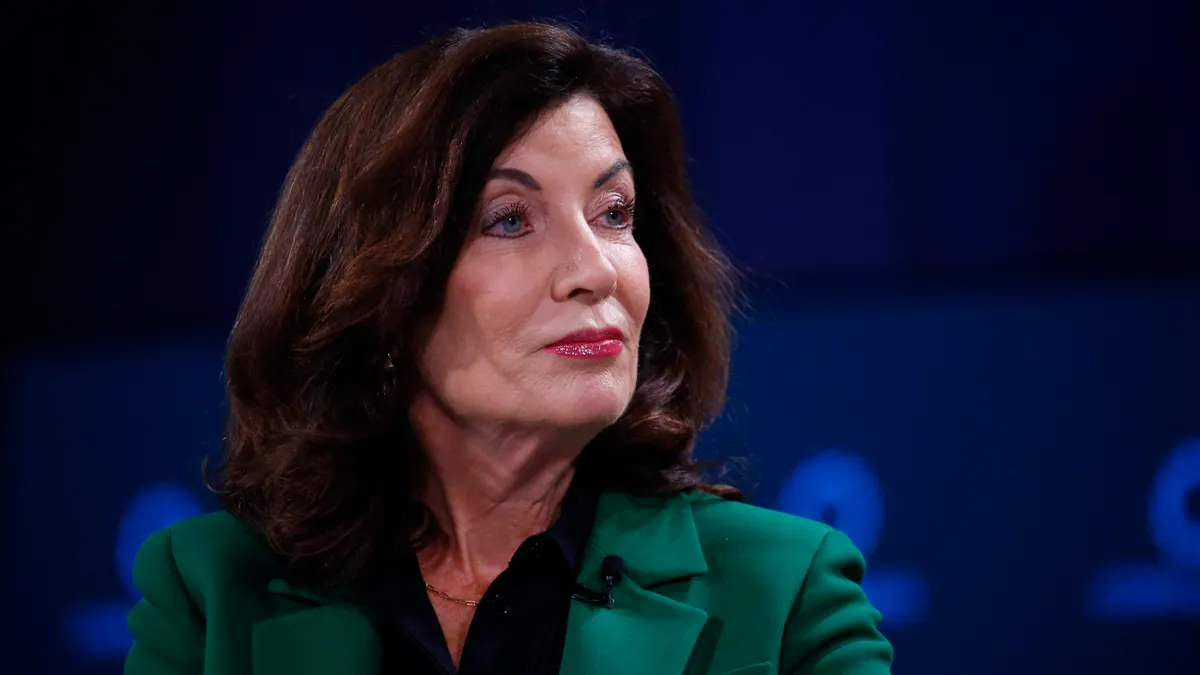The process of getting either an extended producer responsibility plan or bottle bill update into the New York state budget is expected to face numerous hurdles as an April 1 deadline draws closer.
Gov. Kathy Hochul has once again included an EPR for packaging proposal in her version of the budget. Hochul said the Waste Reduction and Recycling Infrastructure Act will increase recycling rates and save local governments money. It’s the second year Hochul has announced such legislation in the budget. Meanwhile, two bills in the New York legislature this year propose similar EPR for packaging programs.
This year’s draft state Senate budget adds to Hochul’s EPR plan and also proposes to expand the state bottle bill. The state Assembly did not include EPR or bottle bill updates in its draft budget, saying the document should focus on finances, not policy matters. Hochul did not include mentions of a bottle bill expansion in her budget.
In 2022, efforts to pass EPR through the state budget failed. This year, the policy faces similar struggles, especially from stakeholders that disagree with details of the program or believe it needs to be hammered out in separate legislation. Though the state’s final budget is expected in early April, some observers expect delays similar to last year, when lawmakers struggled to reach consensus on key issues.
Here is a breakdown of the competing proposals:
Governor Hochul’s version:
- Highlights: Hochul’s EPR bill calls for producers to submit a producer responsibility program plan by Jan. 1, 2026. They would also need to pay a registration fee $500 to $25,000 depending on company size. Producers would reimburse municipalities for the collection, transportation, recovery and processing of paper and packaging materials covered in the bill.
- Recycled content mandates: The bill includes numerous recycled content goals phased in at various starting percentages. Minimum recycled content for rigid plastics would eventually increase to 50%, while non-rigid plastic would reach 40% over time. Cardboard would reach an eventual 40% rate, paper a 70% rate, metal a 90% rate and glass a 50% rate. Food-grade items would be exempt from the requirements for at least 10 years.
- Performance requirements: Producers would need to achieve a recovery rate of 35% and a minimum recycling rate of 25% within five years. Both goals would increase by 10% every five years until the recovery rate hits 85% and the recycling rate hits 75%. The bill also calls for a 15% source reduction target by weight or unit.
- Supporters: Those that want the proposal to stay in the state budget include the New York State Association of Cities, which said it would help “provide relief to local governments.” The Office of the New York City Comptroller said the bill could save the city money: about $50 million by fiscal year 2028 and $100 million from fiscal year 2029 on.
- Pushback from environmental groups: Some environmental groups say EPR should be hammered out in a standalone bill. Beyond Plastics says the proposal falls short on packaging reduction and other metrics. The Natural Resources Defense Council says the bill doesn’t go far enough on key reduction targets or clearly ban chemical recycling technologies from being considered in EPR metrics.
- Packaging groups speak out: Numerous packaging groups such as AMERIPEN, the American Forest & Paper Association, the Foodservice Packaging Institute and others signed a Feb. 14 joint letter saying the provisions were unrealistic and could hurt existing recycling systems, though they believe “improving the recycling systems is a shared responsibility.”
Senate version:
- Expanding EPR proposals: The Senate budget calls for expanding on Hochul’s EPR policy by adding single-use plastic products to the bill, prohibiting “toxic contaminants” in packaging and increasing source reduction requirements, though the bill does not specify those metrics. It also would establish an “office of recycling inspector general” and calls for added environmental justice protections.
- Bottle bill expansion: The draft Senate budget includes provisions from Sen. Rachel May’s proposed bottle bill. That bill would increase the deposit for beverage containers to 10 cents and increase the handling fee to six cents. More types of containers would be accepted, such as wine, liquor and cider, as well as certain soft drinks, juice, coffee and tea. It would also create postconsumer recycled content requirements for returnable containers.
EPR legislation
Two key bills in the New York legislature also call for similar EPR for packaging programs.
- S4246: Led by Sen. Pete Harckham, the bill would require companies with net incomes of more than $1 million to be part of the EPR plan. The bill requires producers to reduce packaging by 50% over 12 years, a timeline supporters like NRDC say is faster than Hochul’s plan. It also phases out chemicals such as PFAS and prohibits chemical recycling from being considered a recycling strategy for EPR purposes. Other supporters include the New York League of Conservation Voters and Beyond Plastics.
- S1064: Led by Sen. May, the sponsor of the bottle bill included in the Senate budget, this bill calls for similar goals but asks for higher reduction targets. It also includes a labeling provision. It would exempt producers that make less than $2 million in revenue or use less than 1 ton of packaging per year. The National Waste and Recycling Association says it does not believe any of the three EPR bills fully address the country’s current recycling management hurdles.
Interested in more packaging news? Sign up for Packaging Dive today.















